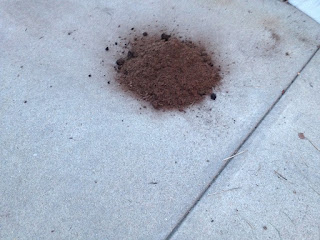There are 2 major types of conditioner or topdressing for
baseball and softball infields.
1.) Calcined Clay
2.) Expanded Shale/Vitrified Clay
What is Calcined
Clay?
First, let’s look at calcined clay. Calcined clay is a
montmorillonite clay fired at 1500 degrees in a rotary kiln. So, in the most
basic terms, the clay is turned into a ceramic—think pottery in art class. Once
the clay is a porous ceramic, it becomes very absorbent—think little sponges.
That is why this material is great for drying a wet infield.
What is a Drying
Agent?
Many drying agents also exist. (Rapid Dry, Quick Dry,
Calcined Clay Drying Agent)
Simply, they are the finest particles of calcined clay. Why do they
absorb moisture better than a coarser grade particle? The smaller particles cover a greater surface area, thus a
quicker “drying” material.
A couple common
misconceptions with calcined clay:
“I can till calcined clay into my infield to raise clay
content.” FALSE.
Once fired, montmorillonite clay is no longer a clay. When
calcined clay is tilled into an infield profile, the infield mix will become
looser and can assist in holding more moisture in the column. Keep in mind,
tilling in too much calcined clay is similar to adding too much sand—the column
will become too loose for play.
“I have to add a drying agent to dry a puddle.” FALSE.
Any calcined clay will absorb water. Keep in mind, the finer
the particle the quicker the absorption of water.
RECOMMENDATION:
Stock only
Pro’s Choice Select calcined clay. This product will work day in and
day out as a topdressing. If additional material is needed to dry a wet
infield, the additional product will not only absorb water but also remain as a
long-term topdressing.
Avoid using drying agents/ rapid dry. While the finest
particle size will dry a wet area quicker, they will negatively effect your
infield mix profile over time.
What is a Vitrified
Clay/ Expanded Shale?
Simply stated, a vitrified clay/expanded shale (
Dura Edge ProSlide) is fired at over 2000 degrees. The product produced is lightweight and
extremely durable. This product will not absorb as much moisture as calcined
clay. During rain events this material will shed water to the base material to
rehydrate the column while also ensuring the water runs off the infield.
Why is Vitrified
Clay/Expanded Shale a Good Choice for Engineered Soils?
Engineered soils are materials that are blended via computer
to ensure that the infield mix is consistent time after time. Due to this fact,
engineered soils are the best product for the value for infield mixes. Engineered soils can take large
rain events and stay firm under foot. Furthermore, engineered soils will not
become dusty when dry.
Due to the above facts, vitrified clay/expanded shale is a
great choice for a couple reasons:
1.
The expanded shale allows for moisture to be
shed to the engineered soil to more quickly drain the rain event while also
allowing moisture to re-hydrate the base material. This is a great benefit for
recreational surfaces that only see moisture during rain events.
2.
The weight of expanded shale (heavier than
calcined clay) will allow the material to stay in place and lessen the chances
of the topdressing “blowing around” the infield.
3. Expanded
shale is produced and available in bulk at a reduced cost. Oftentimes the cost
of bulk material is 1/2 the cost of bagged products.
RECOMMENDATION:
Expanded shale is an extremely durable product that should be considered as the
base topdressing/sliding surface on an infield.
A general rule of thumb is a 50/50 blend of
Pro’s Choice Select Calcined Clay/
Pro Slide as the base topdressing.
This will require 2 pallets (80 bags)
of each product.
This post original post can be viewed here.

















